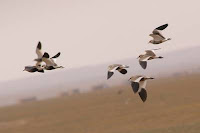News and links about birds, birding, and the environment
 A study of dark-eyed juncos found that some males with increased testosterone levels became more aggressive and more interested in finding extra mates. The extra testosterone also made male juncos less interested in feeding their nestlings.
A study of dark-eyed juncos found that some males with increased testosterone levels became more aggressive and more interested in finding extra mates. The extra testosterone also made male juncos less interested in feeding their nestlings.- This summer's drought may reduce the number of migratory waterfowl that stop on Maryland's Eastern Shore during the winter.
- Wildlife experts gathered at Cape May to call for $1 billion in additional funding for the state Wildlife Action Plans mandated by Congress seven years ago. So far the federal government has provided under $300 million to implement the plans.
- Wetlands in Turkey have come under increasing pressure from pollution and development, leading to population losses among the migratory birds that need them. Turkey sits at the junction of two migratory flyways, one leading through the Balkans and the other between the Black Sea and Caspian Sea.
 Also in Turkey, a satellite tag helped discover the largest flock of sociable lapwings seen for 100 years. The flock numbers 3,200 birds. Previously, the world population of sociable lapwings was thought to be about 400. The tagged lapwing flew 2,000 miles, from north of the Caspian Sea to Ceylanpınar in southeastern Turkey.
Also in Turkey, a satellite tag helped discover the largest flock of sociable lapwings seen for 100 years. The flock numbers 3,200 birds. Previously, the world population of sociable lapwings was thought to be about 400. The tagged lapwing flew 2,000 miles, from north of the Caspian Sea to Ceylanpınar in southeastern Turkey.- The United States will give Costa Rica $26 million in debt relief in exchange for conservation of tropical forests.
 Conservationists from 23 African nations have signed a petition opposing a planned chemical plant at Lake Natron. The lake is home to three-quarters of the world population of lesser flamingos. A chemical plant would disrupt nesting sites and waste from the plant would change the chemical composition of the waters, possibly reducing the availability of food.
Conservationists from 23 African nations have signed a petition opposing a planned chemical plant at Lake Natron. The lake is home to three-quarters of the world population of lesser flamingos. A chemical plant would disrupt nesting sites and waste from the plant would change the chemical composition of the waters, possibly reducing the availability of food.- A cemetery in California is trying to get rid of a flock of about three dozen wild turkeys that have been feeding within the cemetery. (I guess turkeys are not part of a beautiful environment.)
 Some tropical birds depend entirely on army ants to find their food. Birds catch insects and other animals as they flee the approaching horde. Many birds attend to ant hordes as they pass through their territories, others follow the ants but also find other sources of food, while a small number of specialists concentrate only on creatures flushed by the ants.
Some tropical birds depend entirely on army ants to find their food. Birds catch insects and other animals as they flee the approaching horde. Many birds attend to ant hordes as they pass through their territories, others follow the ants but also find other sources of food, while a small number of specialists concentrate only on creatures flushed by the ants.- While the bird population overall is holding steady, farm birds in the U.K. have declined by half over the past forty years.
- In Georgia, a prolonged drought has reduced the number of wood stork nests by almost half.
- Birding offers a natural diversion for city dwellers, as many species can be found within the confines of urban parks over the course of a year.
 Suburban Charlotte, North Carolina, is home to a large and thriving population of barred owls. The owls like the area because it provides old, large trees with holes for roosting and yards with plenty of prey species and clear lanes for hunting.
Suburban Charlotte, North Carolina, is home to a large and thriving population of barred owls. The owls like the area because it provides old, large trees with holes for roosting and yards with plenty of prey species and clear lanes for hunting.- Malaysia may lose 45 bird species to extinction in the near term without the protection of vital habitat.
- A storm reconnected South Monomoy Island to the mainland in November 2006, and since then the former island has been flooded with predators. Newly arrived opossums, raccoons, foxes and coyotes have taken a heavy toll on the threatened species that nest there.
- bootstrap analysis: put your lists into action
- The Nightjar: Farming and Birds
- Evolution: Migration is a mixed strategy for birds
- Journals of an Amateur Naturalist: Intraspecific Fighting Among Female Purple Martins
- The Nemesis Bird: Banding the Saw-whets




